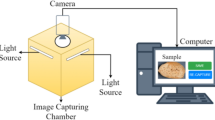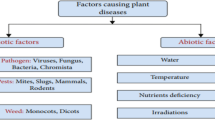Abstract
The demand for efficient and accurate seed assessment is paramount in modern agriculture to ensure good crop yield. This work presents a system for automated seed assaying which utilizes advanced image recognition and deep learning algorithms to streamline the seed segregation process, addressing challenges associated with manual methods. Image analysis was carried out using Deep learning algorithms, enabling the classification as well as identification seeds based on various quality features such as shape, size, color, and surface features. Apart from accelerating the assessment process, this technique also enhances accuracy by minimizing human error and subjectivity. The proposed work employs Resnet50, MobileNetv2, DenseNet121, YOLOv5 and YOLOv8 models for classification of seeds. Among all these models, the YOLOv8 model gave better performance with an accuracy of 91%. The proposed work in this study has the potential to revolutionize seed quality control practices, ultimately contributing to increased agricultural productivity and sustainability.













Similar content being viewed by others
Data Availability
The dataset generated and analyzed during the current study are available from the corresponding author on reasonable request.
References
Qaim M. Genetically modified crops and agricultural development. New York: Palgrave Macmillan; 2016.
Tanwar H, Sharma S, Mor V, Yadav J, Bhuker A. Image analysis: a modern approach to seed quality testing. Curr J Appl Sci Technol. 2018;27:1–11. https://doi.org/10.9734/cjast/2018/40945.
Wu N, Liu F, Bao Y, Li M, Huang W, Meng F, Zhang C, He Y. Rapid and accurate varieties identification of different crop seeds under sample-limited condition based on hyperspectral imaging and deep transfer learning. 2020. https://doi.org/10.21203/rs.3.rs-108818/v1.
Kansiime M, Bundi M, Nicodemus J, Justus O, Marandu D, Njau S, Radegunda K, Williams F, Karanja D, Tambo J, Romney D. Assessing sustainability factors of farmer seed production: a case of the good seed initiative project in Tanzania. Agric Food Secur. 2021;10:15. https://doi.org/10.1186/s40066-021-00289-7.
Qiu Z, Chen J, Zhao Y, Zhu S, He Y, Zhang C. Variety identification of single rice seed using hyperspectral imaging combined with convolutional neural network. Appl Sci. 2018;8:212. https://doi.org/10.3390/app8020212.
Ahmed M, Yasmin J, Park E, Kim G, Kim M, Wakholi C, Mo C, Cho B-K. Classification of watermelon seeds using morphological patterns of X-ray imaging: a comparison of conventional machine learning and deep learning. Sensors. 2020;20:6753. https://doi.org/10.3390/s20236753.
Ahmad IS, Reid JF, Paulsen MR, Sinclair JB. Color classifier for symptomatic soybean seeds using image processing. Plant Dis. 1999;8:320–7. https://doi.org/10.1094/PDIS.1999.83.4.320.
Suma KV, Ranjana R, Kale S, Suresh S, Hiremath SK, Nethra N. Seed quality analyzer and segregator. In: TENCON 2019—2019 IEEE Region 10 Conference (TENCON). 2019. p. 2639–44. https://doi.org/10.1109/TENCON.2019.8929696
Desai MS. Seed quality analysis using image processing and ANN. Int J Trend Sci Res Dev. 2017;1:705–9.
Agrawal D, Dahiya P. Comparisons of classification algorithms on seeds dataset using machine learning algorithm. Compusoft. 2018;7:2760–5. https://doi.org/10.6084/ijact.v7i5.720.
Avudaiappan DT, Sangamithra S, Roselin AS, Farhana SS, Visalakshi KM. Analysing rice seed quality using machine learning algorithms. SSRG Int J Comput Sci Eng (SSRG—IJCSE) Spec Issue ICRTCRET. 2019;474:22–7. https://doi.org/10.1094/PDIS.1999.83.4.320.
Prakash S, Singh SK, Bose R, K MR. Analysing rice seed quality using machine learning algorithms. 2018.
Abdulhamid U, Daniel S, Usman B. Classification of soya beans based image processing techniques and artificial neural network. J Adv Math Comput Sci. 2018. https://doi.org/10.9734/JAMCS/2018/39611.
Ajaz RH, Hussain L. Seed classification using machine learning techniques. J Multidiscip Eng Sci Tech. 2015;2:1098–1102.
Medeiros A, Bernardes RC, Silva L, Freitas BA, Dias D, Silva C. Deep learning-based approach using x-ray images for classifying Crambe abyssinica seed quality. Ind Crops Prod. 2021;164:113378. https://doi.org/10.1016/j.indcrop.2021.113378.
Ahmed M, Yasmin J, Wakholi C, Mukasa P, Cho B-K. Classification of pepper seed quality based on internal structure using X-ray CT imaging. Comput Electron Agric. 2020;179:105839. https://doi.org/10.1016/j.compag.2020.105839.
Yang L, Yan J, Li H, Cao X, Ge B, Qi Z, Yan X. Real-time classification of invasive plant seeds based on improved YOLOv5 with attention mechanism. Diversity. 2022;14:254.
Bose MR, Ranjith K, Prakash S, Singh SK, Vishwanath DY. Intelligent approach for classification of grain crop seeds using machine learning. Int Res J Eng Technol (IRJET). 2018;5:2894.
Harika S, Reddy V, Asani DR, Soppari K. Seed quality testing using deep learning and YOLO v5. 2022. https://doi.org/10.24327/ijrsr.2022.1305.0250.
Yasmin J, Lohumi S, Ahmed MR, Kandpal LM, Faqeerzada MA, Kim MS, Cho B-K. Improvement in purity of healthy tomato seeds using an image-based one-class classification method. Sensors. 2020;20:2690. https://doi.org/10.3390/s20092690.
Junhwa K, Kim N, Park Y, Won C. Object detection and classification based on YOLO-v5 with improved maritime dataset. J Mar Sci Eng. 2022;10:377. https://doi.org/10.3390/jmse10030377.
Wang A, Peng T, Cao H, Xu Y, Wei X, Cui B. Tia-yolov5: an improved yolov5 network for real-time detection of crop and weed in the field. Front Plant Sci. 2022. https://doi.org/10.3389/fpls.2022.1091655.
Rodr´ıguez-Álvarez J, Garc´ıa-Alcaraz J, Vidal R, Soto-Cabral A. Contrasting bean analysis system based on yolov5 and a neural network model using the interval type-2 fuzzy set approach. 2023. https://doi.org/10.2139/ssrn.4510971.
Cardellicchio A, Solimani F, Dimauro G, Petrozza A, Summerer S, Cellini F, Renò V. Detection of tomato plant phenotyping traits using yolov5-based single stage detectors. Comput Electron Agric. 2023;207:107757. https://doi.org/10.1016/j.compag.2023.107757.
Sivakumar D, SuriyaKrishnaan K, Akshaya P, Anuja GV, Devadharshini GT. Computerized growth analysis of seeds using deep learning method. Int J Recent Technol Eng (IJRTE). 2019;7:1885.
Mane V, Puri V. Microwave conductivity and permittivity of moisture laden soybean seed. In: 2008 international conference on recent advances in microwave theory and applications. 2008. p. 168–70. https://doi.org/10.1109/AMTA.2008.4763048.
Nelson SO, Trabelsi S. Measurement of grain and seed microwave permittivity for moisture and density determination. In: Proceedings of the IEEE Southeast- Con 2010 (SoutheastCon). 2010. p. 463–6. https://doi.org/10.1109/SECON.2010.5453809.
Ramos K, Matos J, Martins R, Martins I. Electrical conductivity testing as applied to the assessment of freshly collected Kielmeyera coriacea Mart. seeds. ISRN Agron. 2012;2012:1–5. https://doi.org/10.5402/2012/378139.
Hiremath SK, Suresh S, Kale S, Ranjana R, Suma KV, Nethra N. Seed segregation using deep learning. In: 2019 Grace Hopper Celebration India (GHCI). 2019. p. 1–4. https://doi.org/10.1109/GHCI47972.2019.9071810.
Koppad DB, Suma KV, Nethra N, Sonali CS. Non-destructive technique for agricultural seed classification using deep learning. 2023. p. 695–703. https://doi.org/10.1007/978-981-99-3091-357.
Suma KV, Koppad DB, Awasthi K, Vikas R. Application of AI models in agriculture. In: 2022 4th international conference on circuits, control, communi cation and computing (I4C). 2022. p. 387–90. https://doi.org/10.1109/I4C57141.2022.10057718.
Koppad D, Akhtar S, Alam MM, De SK, Suma KV, Nethra N. Multiple seed segregation using image processing. In: 2023 International Conference on Network, Multimedia and Information Technology (NMITCON). 2023. p. 1–6. https://doi.org/10.1109/NMITCON58196.2023.10275949.
Acknowledgements
The authors acknowledged the Ramaiah Institute. of Technology, Bengaluru, Karnataka, India and University of Agricultural Sciences, Bengaluru, Karnataka, India for supporting the research work by providing the facilities.
Funding
No funding received for this research.
Author information
Authors and Affiliations
Contributions
The collaborative efforts of all authors were instrumental in realizing this research work. Their collective contributions significantly shaped the research outcomes.
Corresponding author
Ethics declarations
Conflict of interest
No conflict of interest.
Additional information
Publisher's Note
Springer Nature remains neutral with regard to jurisdictional claims in published maps and institutional affiliations.
This article is part of the topical collection “Advances in Computational Approaches for Image Processing, Wireless Networks, Cloud Applications and Network Security” guest edited by P. Raviraj, Maode Ma and Roopashree H R.
Rights and permissions
Springer Nature or its licensor (e.g. a society or other partner) holds exclusive rights to this article under a publishing agreement with the author(s) or other rightsholder(s); author self-archiving of the accepted manuscript version of this article is solely governed by the terms of such publishing agreement and applicable law.
About this article
Cite this article
Koppad, D., Suma, K.V. & Nagarajappa, N. Automated Seed Classification Using State-of-the-Art Techniques. SN COMPUT. SCI. 5, 511 (2024). https://doi.org/10.1007/s42979-024-02759-8
Received:
Accepted:
Published:
DOI: https://doi.org/10.1007/s42979-024-02759-8




